Airport Safety Innovation saves lives and made it through the FAA maze with help
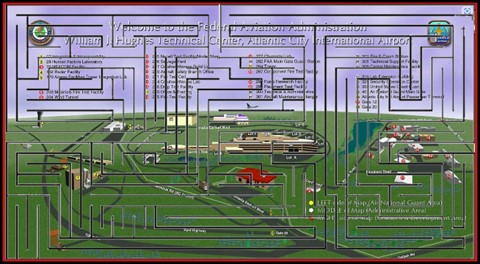

Today’s post highlights a SlashGear insightful article about an important runway safety addition that is likely to be out-of-sight to passengers and an FAA press release touting its participation in the development of this innovation—EMAS–– and this significantly incremental reduction in accidents at airports (all listed in the article).

What neither mentions is the REGULATORY MAZE of the steps, turns, funnels, filters, closed loops, delays, dead ends and success/failure point from application to FINAL ACTION. The William J. Hughes Technical Center (WJHTC) is a multi-faceted, primarily research institution. The transition of EMAS from a research project to a technology to be deployed nationwide and eventually globally touched many of the offices[1] in the New Jersey complex.
The FAA’s charter is safety, and its diurnal task is to protect the public. For a private proponent to move a new concept to real implementation involves understanding the WJHTC organization, the particular perspective of each office, the jargon, euphemisms, acronyms and personality. Knowing when to push, what goals matter, what delays are legitimate {wait} and what are not {push}, what technical data is favored by which WJHTC reviewer, what 3rd party expert has technical currency in the Center, when/if help from above (FOB-10A) and outside (the Hill) matter.
ESCO, as it then was known, hired JDA Aviation Technology Solutions’ founder Joe DelBalzo to manage the FAA’s EMAS process. Roadblocks were avoided, the most powerful data provided, tests designed to provide concrete evidence that this system would work, and path taken based on Joe’s insights into the WJHTC labyrinth. Though Joe is no longer with us, the professionals, who work for his aviation technology solution company, were selected by him for their knowledge of aviation, of the FAA, of the jargon/acronyms and of how to meet safety requirements while introducing new technologies. ESCO valued his sage advice.
[1] The ANG-E Directorate is comprised of six divisions:
- Laboratory Services
- Aviation Research
- Center Operations
- Research & Development Management
- Air Traffic Systems T&E Services
- Enterprise Services T&E
The Center is also home to other FAA organizations:
- Air Traffic Organization
- Program Management Office
- Technical Operations
- Airports
- Aviation Safety
- Chief Counsel
- Civil Rights
- Commercial Space Transportation
- Communications
- Finance and Management CFO
- Acquisition and Business Services
- Information & Technology Services CIO
- Human Resources and Labor Relations
- Security & Hazardous Materials Safety
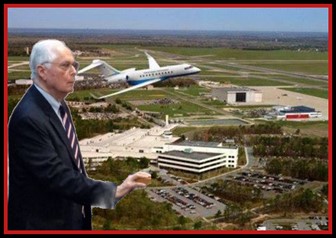
———————————————————————
How The Creation Of EMAS Made A Drastic Change To Airplane Safety
BY BARNABY BRITTON/AUG. 8, 2023 9:53 AM EST
Fear of flying is a very common phobia, fed by the splashy news coverage that typically accompanies any air accident, however minor. But these days, flying is incredibly safe. In fact, in 2022, the accident rate was only one in ~830,000 flights. When it comes to fatal accidents, the statistics are even more reassuring – worldwide, out of 32.2 million flights in 2022, only five resulted in deaths.
If you can excuse the pun, AIR TRAVEL SAFETY IS NO ACCIDENT. For decades, airlines and government agencies have been doing everything they can to make flying safer, and year over year, the number of accidents has decreased as lessons are learned and modifications are made to both planes and crew training. Some flight safety innovations have entered the general lexicon — we’re all familiar with the so-called “black boxes” that record flight data, for example, and countless in-flight briefings have drawn our attention to floor-level illumination, automatically-deploying escape slides, and the emergency oxygen supplies that drop from the airplane ceiling “in the unlikely event that…” etc.
But there’s another innovation being rolled out at airports across the world that has the potential to make air travel even safer, and you’ve probably never heard of it. EMAS, which stands for ” engineered materials arresting system,” is a crushable runway surface designed to reduce the risk of serious accidents during the most dangerous phases of flight.
What is EMAS?
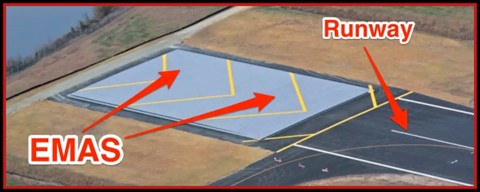
Very simply, EMAS is an “arrestor bed” positioned at both ends of a runway, which is stiff enough to be walked or driven on, but soft enough to crumble under the weight of a plane. Made of either crushable cellular cement or silica, covered with a thin “crust” of poured concrete, EMAS is designed to safely slow an airplane by bogging it down. Imagine the effect of speeding off a highway into a plowed field, and you’ll get the idea. An EMAS arrestor bed can bring an airplane that leaves the runway at 80 miles per hour safely and quickly to a stop.
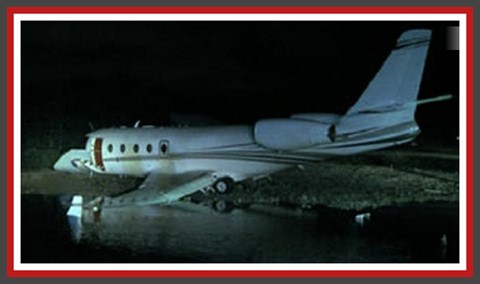
You might assume that the most dangerous part of a flight is when you’re cruising at altitude, miles above the earth. But in fact, most airplane accidents happen close to the ground, either during takeoff or landing. Although the takeoff phase only accounts for a fraction of an average flight time, it’s where 14% of fatal accidents occur. The final approach and landing phase is (statistically) even more dangerous, accounting for 49% of fatal accidents (based on data from 2008-2017).
There are many reasons for this, which include the risk of engine failure before the plane has built up enough speed to get safely airborne, the danger of bird strikes, and wet or icy runways, which might cause a plane to skid on landing. In each of those eventualities, adding additional space at the ends of runways provides a valuable safety margin. In fact, runway safety area (RSA) standards were put in place in the 1980s, specifically for this reason. But not every airport has the luxury of extending its runways by the recommended distance. For passengers flying from those airports, EMAS might make the difference between life and death.
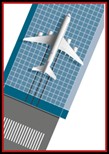
EMAS rollout around the world
EMAS was first introduced at New York’s John F Kennedy Airport in 1996, and since then, it has been installed at 69 airports in the US, and many more worldwide. It’s especially useful at airports with short runways that end in dangerous natural features, like hills, valleys, or the ocean. Roland Garros Airport is one of them. Located in Saint-Marie, on the French island of Réunion, the airport’s runways could not be safely extended, so in 2017, EMAS was installed to reduce the risks of planes overshooting and ending up in the sea.
According to the FAA, since it was first installed at JFK back in the 90s, there have been 20 incidents involving 18 airplanes, where EMAS HAS BEEN CREDITED WITH SAFELY BRINGING THE AIRPLANE TO A STOP. These include a Boeing 737 carrying then Vice-Presidential candidate Mike Pence, which skidded off the runway in wet conditions at La Guardia airport in 2016 and was safely stopped by EMAS. After an accident involving EMAS, the runway can be returned to operation within just a few hours, and the damaged portions of the arrestor bed can be replaced easily and cheaply without re-installing the entire system.
As a passenger, you likely wouldn’t notice an EMAS arrestor pad if you didn’t know exactly what you were looking for. If you get on Google Earth, though, and find one of the airports with EMAS installed, you might notice that the runways have dark-colored extensions at either end, with bright arrows painted on them. That’s EMAS, and it might save your life one day.
Read More: https://www.slashgear.com/1360173/creation-emas-airplane-safety/
————————————————-
Engineered Material Arresting System (EMAS)
Friday, August 4, 2023
Background
The runway safety area (RSA) enhances the safety of aircraft that undershoot, overrun, or veer off the runway. The RSA provides a clear, graded area which provides additional space for pilots to bring their aircraft to a safe stop. Though RSAs vary in size by runway, they can be as large as 500 feet wide and often extend 1,000 feet beyond each end of the runway. Many airports were built before the current RSA dimensional standards were adopted in the 1980s. In some cases, it is not practicable to achieve the full standard RSA because there may be a lack of available land. There also may be obstacles such as bodies of water, highways, railroads, and populated areas or severe drop-off of terrain

The FAA began conducting research in the 1990s to determine how to improve safety at airports where the full RSA cannot be obtained. Working in concert with the University of Dayton, the Port Authority of New York and New Jersey, and the Engineered Arresting Systems Corporation (ESCO, now Runway Safe Inc., of Logan Township, NJ), a new technology emerged to safely arrest overrunning aircraft. EMAS uses crushable material placed at the end of a runway to help stop an aircraft that overruns the runway. The tires of the aircraft sink into the lightweight material and the aircraft is decelerated as it rolls through the material.
Benefits of the EMAS Technology
The EMAS technology improves safety benefits in cases where land is not available for an RSA of standard dimensions. A standard EMAS installation can stop an aircraft overrunning the runway at 70 knots (approximately 80 miles per hour). An EMAS bed can be installed to help slow or stop an aircraft that overruns the runway, even if less than a standard RSA length is available.
EMAS Manufacturers
Runway Safe acquired the EMASMAX® product range from ESCO as of February 2020. Runway Safe is the sole manufacturer of EMAS products that meet the FAA standards of Advisory Circular 150-5220-22B, “Engineered Materials Arresting Systems for Aircraft Overruns.” Currently, Runway Safe has two EMAS systems, the cellular concrete block system called EMASMAX® and a silica foam system called greenEMAS®.
The FAA reviews and approves each EMAS installation.
EMASMAX® is the latest, most durable version of Runway Safe’s block based EMAS, developed with and technically accepted by the FAA. EMASMAX® arrestor beds are composed of blocks of lightweight, crushable cellular cement material.
Runway Safe’s greenEMAS® is a foamed silica bed which is made from recycled glass and is contained within a high-strength plastic mesh system anchored to the pavement. The foamed silica is poured into lanes bounded by the mesh and covered with a poured cement layer and treated with a topcoat of sealant.
Both EMAS products are located at the end of the runway and are typically the full width of the runway. The length depends on the airport configuration and the aircraft fleet using the airport.
Background
The Runway Safe Group and Safran Aerospace Arresting (formerly Engineered Arresting Systems Corporation, or ESCO), a subsidiary of the Safran Group entered into an agreement for Runway Safe to acquire the ESCO EMAS business. This transaction was completed in February of 2020.
Current FAA Initiatives
The FAA’s Office of Airports has made RSA improvements at more than 500 commercial service airports. This means that all practicable improvements, including the use of EMAS technology, have been made at approximately 1,000 runway ends at these airports. These RSAs have been improved to full standards or to the extent practicable, not including the relocation of FAA-owned navigational equipment. As a result of the success in addressing commercial service airport RSA’s, the Office of Airports has started a similar strategy into the potential of improving General Aviation RSA’s across the Country.
EMAS Arrestments
To date, there have been 20 incidents where EMAS systems have safely stopped 18 overrunning aircraft, carrying 428 crew and passengers, aboard those flights.
EMAS Arrestments
| Date | Crew and Passengers | Incident |
|---|---|---|
| May 1999 | 30 | A Saab 340 commuter aircraft overran the runway at John F Kennedy (JFK) Airport in New York |
| May 2003 | 3 | A Gemini Cargo MD-11 overran the runway at JFK Airport in New York |
| January 2005 | 3 | A Boeing 747 overran the runway at JFK Airport in New York |
| July 2006 | 5 | A Mystere Falcon 900 overran the runway at Greenville Downtown Airport (GMU) in South Carolina |
| July 2008 | 145 | An Airbus A320 overran the runway at Chicago O’Hare Airport (ORD) in Chicago, IL |
| January 2010 | 34 | A Bombardier CRJ-200 regional jet overran the runway at Yeager Airport (ORW) in Charleston, WVA |
| October 2010 | 10 | A G-4 Gulfstream overran the runway at Teterboro Airport (TEB) in Teterboro, NJ |
| November 2011 | 5 | A Cessna Citation II overran the runway at Key West International Airport (DYW) in Key West, FL |
| October 2013 | 8 | A Cessna 680 Citation overran the runway at Palm Beach International Airport (PBI) in West Palm Beach, FL |
| January 2016 | 2 | A Falcon 20 overran the runway at Chicago Executive Airport (PWK) in Wheeling, IL |
| October 2016 | 37 | A Boeing 737 overran the runway at LaGuardia Airport (LGA) in Flushing, NY |
| April 2017 | 2 | A Cessna 750 Citation overran the runway at Bob Hope Airport (BUR) in Burbank, CA |
| February 2018 | 4 | A Beech Jet 400A overran the runway at Burke Lakefront Airport (BKL) in Cleveland, OH |
| December 2018 | 117 | A Boeing 737 overran the runway at Bob Hope Airport (BUR) in Burbank, CA |
| February 2019 | 1 | An Embraer Phenom 100 overran the runway in Kansas City Airport (MCI), MO |
| February 2021 | 2 | A Dassault F900 overran the runway at Chicago Executive-Wheeling (PWK), IL |
| July 2021 | 9 | A Cessna Citation Excel overran the runway at Reading Regional Airport (RDO), PA |
| September 2021 | 2 | An Aero Vodochody F-13 overran the runway at Witham Field Airport (SUA) at Stuart, FL |
| March 2022 | 2 | A Cessna 650 overran the runway at Key West International Airport (EYW) in Key West, FL |
| April 2023 | 7 | A Cessna 402C overran the runway at Fort Lauderdale International Airport (FLL), in Fort Lauderdale, FL |
EMAS Installations with EMASMAX®
EMASMAX® is installed at 121 runway ends at 71 airports in the United States.
EMAS Installations
| ` | Location | # of Systems | Installation Date(s) |
|---|---|---|---|
| + Reliever airport | |||
| JFK International (JFK) | Jamaica, NY | 2 | 1996(1999)/2007 (2014) |
| Minneapolis St. Paul (MSP) | Minneapolis, MN | 1 | 1999(2008) |
| Little Rock (LIT) | Little Rock, AR | 2 | 2000/2003 (2018) |
| Rochester International (RST) | Rochester, NY | 1 | 2001 |
| Burbank (BUR) | Burbank, CA | 1 | 2002* (2017) |
| Baton Rouge Metropolitan (BTR) | Baton Rouge, LA | 1 | 2002 |
| Greater Binghamton (BGM) | Binghamton, NY | 2 | 2002 (2012)/2009*** |
| Greenville Downtown (GMU) | Greenville, SC | 1 | 2003**/2010*** |
| Barnstable Municipal (HYA) | Hyannis, MA | 1 | 2003 |
| Roanoke Regional (ROA) | Roanoke, VA | 1 | 2004 |
| Fort Lauderdale International (FLL) | Fort Lauderdale, FL | 4 | 2004 (2019), 2014 |
| LaGuardia (LGA) | Flushing, NY | 4 | 2005 (2014)/2015 |
| Boston Logan (BOS) | Boston, MA | 2 | 2005/2006 (2012)/(2014) |
| Laredo International (LRD) | Laredo, TX | 1 | 2006/2012*** |
| San Diego International (SAN) | San Diego, CA | 1 | 2006 |
| Teterboro (TEB) | Teterboro, NJ | 3 | 2006+/2011/2013 |
| Chicago Midway (MDW) | Chicago, IL | 0 | Replaced |
| Merle K (Mudhole) Smith (CDV) | Cordova, AK | 1 | 2007 |
| Charleston Yeager (CRW) | Charleston, WV | 1 | 2007 (2019) |
| Manchester (MHT) | Manchester, NH | 1 | 2007 |
| Wilkes-Barre/Scranton Intl.(AVP) | Wilkes-Barre, PA | 2 | 2008 |
| San Luis Obispo (SBP) | San Luis Obispo, CA | 2 | 2008 |
| Chicago-O’Hare (ORD) | Chicago, IL | 2 | 2008 |
| Newark Liberty International (EWR) | Newark, NJ | 2 | 2008/2015 |
| Charlotte Douglas International (CLT) | Charlotte, NC | 1 | 2008 |
| St. Paul Downtown (STP) | St. Paul, MN | 2 | 2008+ |
| Worcester Regional (ORH) | Worcester, MA | 2 | 2008/2009** |
| Reading, Regional (RDG) | Reading, PA | 1 | 2009** |
| Kansas City Downtown (MKC) | Kansas City, MO | 2 | 2009+/2010 |
| Smith Reynolds (INT) | Winston-Salem, NC | 1 | 2010 |
| New Castle County (ILG) | Wilmington, DE | 1 | 2010 |
| Key West International (EYW) | Key West, FL | 2 | 2010/2015 |
| Arcata-Eureka (ACV) | Arcata, CA | 1 | 2010 |
| Telluride Regional (TEX) | Telluride, CO | 2 | 2010 |
| Palm Beach (PBI) | Palm Beach, FL | 1 | 2011 |
| Republic (FRG) | Farmingdale, NY | 2 | 2011/2013 |
| Martin County (SUT) | Stuart, FL | 2 | 2011 |
| Lafayette (LFT) | Lafayette, LA | 3 | 2011/2013/2016 |
| Cleveland Hopkins (CRE) | Cleveland, OH | 2 | 2011 |
| Groton-New London (GON) | Groton, CT | 2 | 2011 |
| Augusta State (AUG) | Augusta, ME | 2 | 2011 |
| Elmira-Corning (ELM) | Elmira, NY | 1 | 2012 |
| Trenton-Mercer (TTN) | Trenton, NJ | 4 | 2012/2013 |
| New Bern (EWN) | New Bern, NC | 1 | 2012 |
| Memphis (MEM) | Memphis, TN | 1 | 2013 |
| Burke Lakefront (BLK) | Cleveland, OH | 1 | 2013 |
| San Francisco (SFO) | San Francisco, CA | 4 | 2014 |
| T.F. Green (PVD) | Providence, RI | 3 | 2014/2015/2017 |
| Addison (ADS) | Addison, TX | 1 | 2014 |
| Chicago Executive (PWK) | Wheeling, IL | 2 | 2014/2015 |
| Reagan National (DCA) | Washington, DC | 3 | 2014/2015 |
| Monterey (MRY) | Monterey, CA | 2 | 2015 |
| Oakland International (OAK) | Oakland, CA | 1 | 2015 |
| Nome (OME) | Nome, AK | 1 | 2015 |
| Lehigh Valley (ABE) | Allentown, PA | 2 | 2015 |
| John Tune (JWN) | Nashville, TN | 1 | 2015 |
| Kodiak (ADQ) | Kodiak, AK | 2 | 2015 |
| Rutland (RUT) | Rutland, VT | 1 | 2015 |
| Sikorsky (BDR) | Bridgeport, CT | 1 | 2015 |
| McAllen International (MFE) | McAllen, TX | 1 | 2015 |
| Sandiford (SDF) | Louisville, KY | 1 | 2015 |
| Venice (VNC) | Venice, FL | 1 | 2016 |
| Boca Raton (BCT) | Boca Raton, FL | 2 | 2017 |
| DeKalb/Peachtree (PDK) | Atlanta, GA | 1 | 2018 |
| Cuyahoga (CFG) | Cleveland, OH | 2 | 2018 |
| Lafayette (LFT) | Lafayette, LA | 1 | 2018 |
| Little Rock (LIT) | Little Rock, AR | 1 | 2018 |
| Waterbury-Oxford (OXC) | Oxford, CT | 1 | 2018 |
| Hilton Head (HXH) | Hilton Head, SC | 2 | 2018 |
| Cartersville (VPC) | Cartersville, GA | 2 | 2021/2023 |
| Blue Grass (LEX) | Lexington, KY | 2 | 2022/2023 |
| ( ) Bed replaced | |||
| * Widened in 2008 | |||
| ** General aviation airport | |||
| *** retrofitted bed | |||
EMAS Installations Using greenEMAS®
greenEMAS® is installed at four runway ends at one airport in the United States.
EMAS Installations Using Runway Safe EMAS
| Airport | Location | # of Systems | Installation Date(s) |
|---|---|---|---|
| Chicago Midway (MDW) | Chicago, IL | 4 | fall 2014/2015/2016 |
====================================================